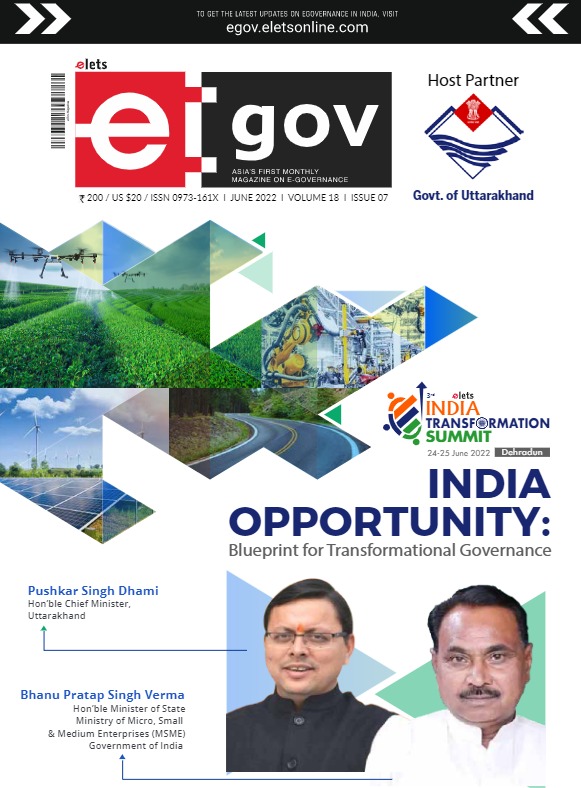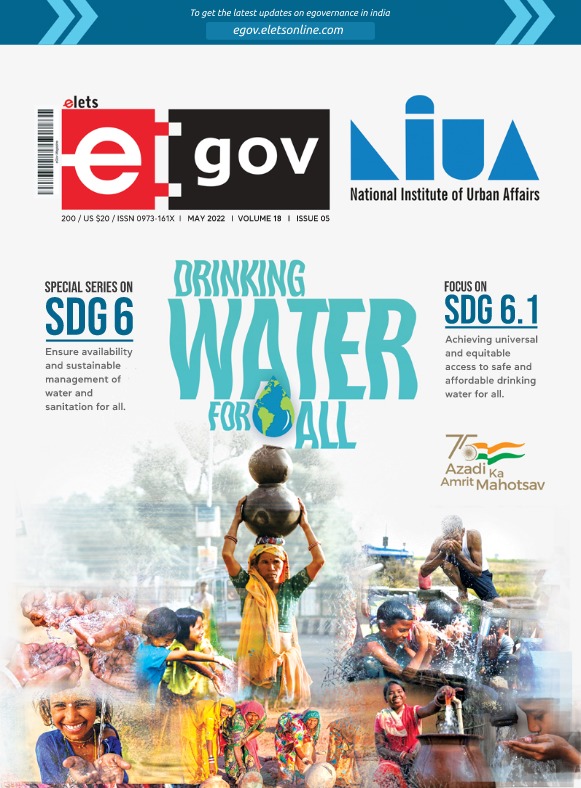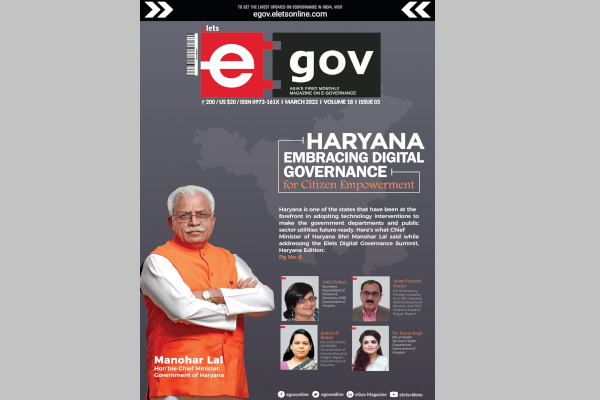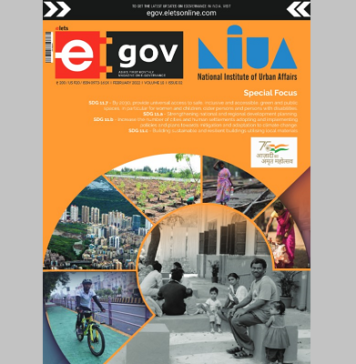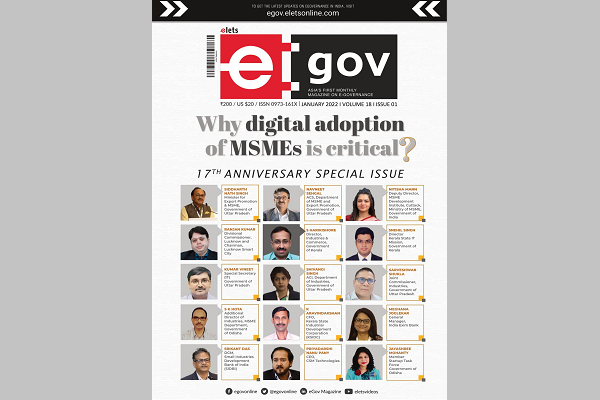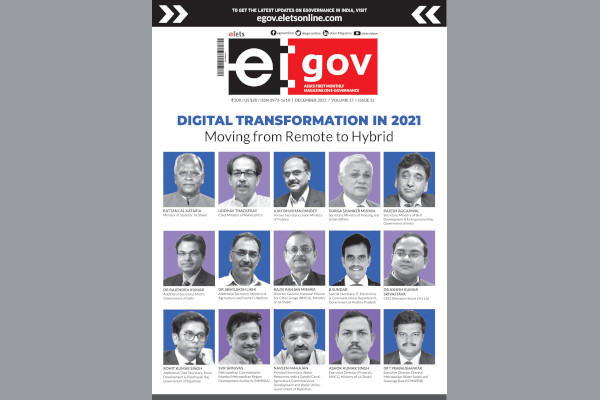
 With the State government led by Yogi Adityanath determined to transform Uttar Pradesh (UP), Smart Cities Mission is emerging as a ray of hope to realise this dream. As intensive use of smart solutions to develop smarter and sustainable cities in the country is gaining pace, UP is marching ahead in sinc with the time, observe Arpit Gupta and Ahmad Shariq Khan of Elets News Network (ENN).
With the State government led by Yogi Adityanath determined to transform Uttar Pradesh (UP), Smart Cities Mission is emerging as a ray of hope to realise this dream. As intensive use of smart solutions to develop smarter and sustainable cities in the country is gaining pace, UP is marching ahead in sinc with the time, observe Arpit Gupta and Ahmad Shariq Khan of Elets News Network (ENN).
In recent times, led by Lucknow, numerous Smart City Missions of Uttar Pradesh have rolled out a number of citizen-engagement projects. To boost the holistic ecosystem of the State’s infrastructure, the Uttar Pradesh Government has roped in many relevant stakeholders, expert urban planners and globally renowned teams of engineers to chalk out plans to transform State’s infrastructure and civic development. Ever since being shortlisted as a Smart City in 2016 by the Central Government , Lucknow also described as the City of Nawabs , has made efforts to turn around its image and transform the city as a tech-driven city.
Till recently, representing a perfect blend of the old and the new, Lucknow has been known largely for its rich culture, cuisine, linguistic heritage, and tourism Noteworthy here are innovative developments on projects such as: Integrated Control and Command Centre Smart city surveillance system, smart mobility solutions, traffic management initiatives and initiatives such as Swachhch Lucknow.

Thanks to a proactive State establishment, playing the role of an effective facilitator, the city’s existing infrastructure is dotted with many symbols of innovations. Right from the steadily consolidating infrastructure i.e. international airports, flyovers, upcoming metro rail, IT parks and real estate development to fast growing social infrastructure, every facet of urban housing is being given a makeover. A close look offers an insight into how all along, these UP cities besides taking up the developmental plank in a big way, did not lose hold of their respective cities’ old charm and magnificence. Perhaps, this is the best feature of such an innovative way of development.
A cursory glance at Lucknow Smart City Ltd, the designated agency mandated with the role of enhancing the profile of the city as a Smart City destination, offers an interesting insight. Lucknow Smart City Ltd – A Vision of Holistic Development “While transforming the Lucknow City into a world-class Smart City, we are also focussing on developing this historic city into an International culture and heritage centre,” says Anil Garg, Divisional Commissioner, Lucknow and Chairman, Lucknow Smart City Limited.

As per the Vision Document of the Lucknow Smart City Ltd (LSCL), this special purpose vehicle (SPV) has been formed to give impetus to smart city project in the city and synergising solutions for citizens and city is its only motto. “Lucknow Smart City aspires to leverage its culture and heritage by investing in inclusive and transformative solutions that enhance the quality of life for its citizens,” states the vision document, adding that “addressing the next generation of urban challenges doesn’t mean you have to overhaul the entire city.
In fact, our approach toward making Lucknow a Smart City involves improving resource management by adding connectivity and intelligence within existing infrastructure”. With the aforementioned guiding principle, currently, the focus and blueprint for Lucknow Smart City comprise strategic interventions on four focal points:
Jeevant Lucknow (Liveable Lucknow): Providing better infrastructure facilities to citizens.
Sugam Lucknow (Mobility Lucknow): Improvising the newage transport and mobility factorising the day-to-day life of citizens.
Swachh Lucknow (Clean Lucknow): Improving health, hygiene and sanitation practices for maintaining the wellness quotient for city’s citizens.
Samruddh Lucknow (Prosperous Lucknow): Harnessing on its strengths of heritage, culture, handicraft, cuisine and connectivity to encourage tourism by strengthening the support system that eventually facilitates employment (direct and indirect).
Elaborating on the focal points of the Smart City proposal of Lucknow, says Garg: “Under Sugam Lucknow, Integrated Traffic Management System (ITMS) is under implementation, which led to junction improvement, intelligent traffic signals and traffic sensors. There is a provision of variable message signs, pelican crossing, augmentation on and strengthening of the existing command centre.” Thereby, keeping into account the very fact that smart city solutions are ultimately meant to actualise the idea of ‘better cities’ from a holistic perspective encompassing social, economic and environmental aspects, Lucknow has undertaken many initiatives.
All city-wide solutions seem to have been envisioned with a view to transform the existing city into a developed, clean, green and citizenfocussed city with a modern economy and outlook anchored in its traditional heritage and culture. Anil Garg, Divisional Commissioner, Lucknow and Chairman, Lucknow Smart City Limited, says: “We are also implementing Master System Integrator to integrate various smart solutions under the Control and Command Centre by M/s Fluentgrid in consortium with M/s BELL.
This system will integrate all city specific IT-enabled services. Asked about the flagship Smart City Surveillance Project called ‘Drishti’, successfully implemented by Lucknow Smart City Mission, Garg adds, “ The project that has been acknowledged as one of the fastestimplemented projects for any police department in India, incorporating the latest technologies and a state-of-theart Command and Control Centre for 24×7 monitoring of CCTV cameras.” Under project ‘Drishti’, a total of 280 cameras are operational at 70 locations across the city.
Ever since its introduction, a unique Rs 40-crore worth project , which boasts of a total of 80 IP CCTV, Automatic Number Plate Recognition System (ANPR), Video Analytics, Mobile Surveillance System, Command Control Centre and Data Centre, has proved to be very useful to curb crimes in the city. The project presently covers 70 junctions in Lucknow, with a dedicated focus on entry and exit points of the city, VVIP areas, and all critical and sensitive hotspots. Plans are afoot to increase the number of cameras for the system.
Another thrust area being focused by various State Smart City Missions is Solid Waste Management System (LMS). Various Smart City missions , including Lucknow Municipal Corporation, have implemented ICT-enabled Solid Waste Management system in Lucknow City under the PPP mode. It includes setting up of control and command centre for real-time tracking of garbage collection vehicles and user charge collection; designing route plan for all wards/zones to monitor and control timely service for each household.
 It also includes customer redressal mechanism for timely resolving all complaints received, MIS Reports generation, among others. The project has a concept of deployment of RFID tag smart road bins (sensor based) which will provide the real-time information of availability of waste in each bin on a real-time basis so that quick and prompt action can be made to dispose of the pending waste in all bins. One of the essential components of the system is the generation of the energy from the waste collected from the city. Similar initiatives are currently being implemented by various other smart city missions across Uttar Pradesh too.
It also includes customer redressal mechanism for timely resolving all complaints received, MIS Reports generation, among others. The project has a concept of deployment of RFID tag smart road bins (sensor based) which will provide the real-time information of availability of waste in each bin on a real-time basis so that quick and prompt action can be made to dispose of the pending waste in all bins. One of the essential components of the system is the generation of the energy from the waste collected from the city. Similar initiatives are currently being implemented by various other smart city missions across Uttar Pradesh too.
Mentioning about a similar initiative by their mission, Santosh Kumar Sharma Commissioner Kanpur Nagar Nigam and Chief Executive Officer, Kanpur Smart City Limited, said: “Under our ICT based Solid Waste Collection-Transfer Station project, development works at Bhairav Ghat and Phoolbagh site have been completed. In Janta Nagar, and Chunniganj and Panki Sites, 50 percent construction work has been completed and remaining work is in progress.” Likewise, an emphasis on promoting eco-friendly cities and the idea of renewable energy also figures among the key thrust area of various state missions.
“One of the important components of the Bareilly Smart Cities Mission is to promote clean and green energy, for which there is a project of installing solar panels on the rooftops of government buildings in Bareilly Smart City,” says Rajesh Kumar Srivastava, Municipal Commissioner, Bareilly. Further, along with solar-based water ATMs, plans are being mulled to develop and rejuvenate certain water bodies and parks as recreational spots which should enrich the social and cultural character of the city, he adds.
In addition, an integrated system for grievance redressal is to achieve the goal of good governance using latest technology involving all stakeholders. It is an important thrust area being taken up by almost all State’s smart city missions. Through this innovative mechanism, a citizen can freely and conveniently file a grievance, track the grievance lodged on all important platforms and receive a response to his satisfaction both in terms of quality and time. Besides, the state government has also launched a mobile app for registering citizens’ grievances/suggestions. It is linked to the Jansunwai (IGRS, the Public Grievances registration and redressed portal ) portal of the government, where grievances/suggestions can also be registered through web (jansunwai.up. nic.in).
A fast and user-friendly interface has been provided for registering and tracking of grievance through mobile phones. Each grievance will be provided with a unique reference number. A citizen can use this reference number to track the progress of grievances, send reminders and also for giving feedback after disposal. After successful registration, the reference will be automatically forwarded to the concerned officer for redressal of grievances. Another related project worth mentioning is the Women Power Line 1090 — an IVRS and App based dedicated service in Lucknow to empower women from all forms of harassment and ensure their safety in society.
It’s is a toll-free number for immediate help to the harassed women suffering from an anti-social behaviour or any other format of assistance required. Private Sector – A True Friend Ensuring Growth Thanks to the active role played by the private sector in the development of various cities across Uttar Pradesh, the State’s cities, in many ways, are smart cities in the making. Today, a lot of physical infrastructure — international airports, flyovers, upcoming metro rail, IT parks, real estate development and growing social infrastructure – are coming into existence, courtesy the private sector.
It’s deserves the credit of bringing along world-class technical know-how, skilled manpower and adding numerous other strengths in the State. Lauding the role of private sector in the development of the State’s capital, Garg, the Divisional, Commissioner, Lucknow, says: “To further accelerate the city’s development and to fully harness the utility of private sector in executing various citizen-centric initiatives, we have promoted public-private partnerships in many sectors such as electricity supply, roads, expressways, and educational ventures.”
Public Bike Sharing project under PPP mode is being executed by many Smart city missions. The unique arrangement allows users to commute using bicycles which can be picked from a station near the origin and returned to any other station near your destination. In Lucknow, M/s Zoom Car Pvt Ltd launched the public bike sharing on a pilot-basis in Gomti Nagar, at a cost of Rs 60 lakh .
A similar project is also being implemented under Allahabad Smart City Proposals (Phase –II). Another example worth citing could be of Reliance Jio — that in consultation with Department of Police had installed approx 1100 cameras free of cost on its towers across Lucknow.
Likewise, Solar Traffic Control Signal System and Low Green Energy Solar Traffic Control Systems are being implemented under PPP modes. Similarly, in Kanpur, the Skill Development Business and Economic Centre is being developed under the PPP model. The major economic hotspot will be located at the strategic location of Mall Road – at an area of 3.87 acres. A case in point is the Kumbh Mela at Prayagraj to be held between January 15 to March 4 in 2019. For this, the State’s Department of Tourism has engaged a professional agency to conceptualise, plan and implement marketing activities for Kumbh 2019, including: Development of posters, booklets, brochures, tourist maps, print campaigns, social media management, radio and commercials and for media planning and services.
In essence, the Uttar Pradesh is emerging as a perfect example how private sector can be optimally engaged as partners of development and creating avenues of growth at any place. With a vision aimed at developing growth avenues and holistic growth for all, the Uttar Pradesh Smart Cities are catalysing development, inspiring one and all.
MAJOR SMART –CITY CENTRIC INITIATIVES
State Data Centre ( SDC)
The State Data Centre is one of the Core Infrastructure Project implemented by the State. SDC is a centralised reservoir for data, information and services (Central infrastructure to build a central repository of information/data) for various departments of Government of Uttar Pradesh. SDC is operational since 6th August 2012. Various State Departments such as Basic Education, Home (Police) and Commercial Tax, Urban Development, Social Welfare, Rural Engineering, Forest, IT & Electronics etc. have been hosted in the SDC.
Digi-Locker
Digi-Locker is an IT-enabled platform for issuance and verification of documents and certificates in a digital way, thus eliminating the use of physical documents. Making use of this facility, Indian citizens who sign up for a DigiLocker account get a dedicated cloud storage space that is linked to their Aadhaar (UIDAI) number. Organisations that are registered with Digital Locker can push electronic copies of documents and certificates (e.g. driving license, Voter ID, School certificates) directly into citizens lockers. Citizens can also upload scanned copies of their legacy documents in their accounts. These legacy documents can be electronically signed using the eSign facility.
Online Ration Management System ( ORMS)
Online Supply Chain management or Ration Management System is a portal based application developed by National Informatics Centre for Food and Civil Supply Department for monitoring and allocation of ration at various levels in a district. The applications are developed in such a way that there is a provision of creation of users at various level say Distribution branch, Supply Branch, Accounts Branch etc.
Network Systems( CCTNS)
The Crime and Criminal Tracking Networks and Systems, abbreviated to CCTNS, is a project under Indian government for creating a comprehensive and integrated system for effective policing through e-Governance. Uttar Pradesh Police started This Crime and Criminal Tracking Network & Systems (CCTNS) on trial basis. Under the project e-FIR system was introduced for citizens for filing the e-FIR for various types of crimes.
Integrated Transport Management System ( UPSRTC)
UPSRTC has implemented Intelligent Transport Management System (ITMS) Project for real-time tracking of a fleet of more than 10000 buses and having provisioning of other services for benefit of the passengers. These services include electronic ticketing, GPS based vehicle tracking and Passenger Information systems. Intelligent Transportation Management System (ITMS) is passenger-centric and has projected positive impact on the performance and profitability of UPSRTC.
Online Public Grievance Redressal System
Lucknow Municipal Corporation has developed an online public grievance Redressal system along with an integrated room for monitoring and taking the action on the grievances raised by the citizens on the portal or through the landline. At present, the LMC is dealing with complaints like sewerage, drinking water, Street Light, Tax, encroachment, street light etc.
Be a part of Elets Collaborative Initiatives. Join Us for Upcoming Events and explore business opportunities. Like us on Facebook , connect with us on LinkedIn and follow us on Twitter, Instagram.




